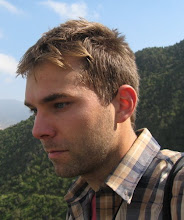
Jbel Toubkal, at 4,167 meters (13,671 ft), is the highest mountain in Morocco and all of North Africa. It's located about an hour southeast of my town as the crow flies, in Toubkal National Park.

I hiked with five others-- two fellow PCVs and three guys visiting from the States. The way it works is on Day One, you hike from Imlil, the nearest town, through the mountain valleys to the "refuge", a lodge situated at the base of Toubkal, and spend the night. On Day Two, you wake up early, hike to the summit, descend, and then head all the way back to Imlil. In theory it sounds like a bit much, and the idea of actually carrying out such a plan was more that a little daunting on the punishing, five hour uphill trek to the refuge. The tops of the mountains looked pretty far away, at least to my Illinois eyes.

As we arrived at the refuge late in the afternoon, the weather changed dramatically. A fog descended the surrounding peaks into the valley, and we opted for fleeces and stocking caps instead of the t-shirts and shorts we'd been wearing all day. A hailstorm unleashed itself, and within an hour the summery green expanses were whitened and frigid.
The refuge was much fancier than I had expected; it was a bona fide "lodge", complete with a Great Room, fireplace, hot showers, many bunk bed-filled chambers, and a staffed kitchen, running on solar power. There are no roads leading to it. I would love to know how they built it in such a remote area. I picture donkeys loaded down with porcelain toilets and light fixtures, which is probably not far from the truth.


We had some dinner and relaxed amid tables of people from all over the place, as many different languages chattered around us. Despite the exhaustion, I had a difficult time sleeping that night, partially due to an unpleasant-smelling pillow.
We awoke at 4 a.m. and ate a light breakfast by flashlight as everyone else slept. After waiting until the sun showed the tiniest hint of rising, turning the sky from black to deep purple, we headed out into the chilly morning air. Not knowing the route up to the summit and without any knowledgeable guide present, our group hit a few false starts and dead ends before spotting the glow of several headlamps bobbing along single-file in the distance. We followed them, and the rising sun slowly turned the snow-streaked mountainsides orange.

It was probably a three hour hike to the top, climbing steeply over rocky areas and icy slopes, slick from the previous night's storm. A bit treacherous, as we were not equipped with and special "gear", but nothing I was ever too worried about. At one point you hit a ridge over which everything on the other side is visible-- incredibly beautiful.



The last leg is a hike up the snowy ridge to the summit, marked by a strange metal teepee. I made it up first and indulged in a celebratory can of tuna, took some photos and sat to take in the view.


















